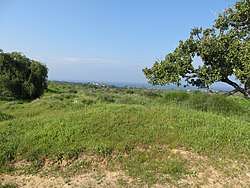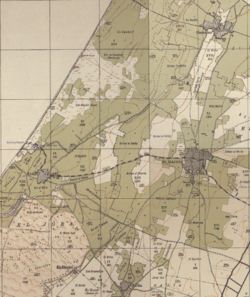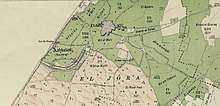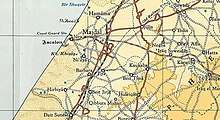Al-Jura
Al-Jura (Arabic: الجورة) was a Palestinian village that was depopulated during the 1948 Arab-Israeli war, located approximately two kilometers west of Majdal (both within the boundaries of present-day Ashkelon, Israel). In 1945, the village had a population of approximately 2,420 mostly Muslim inhabitants. Though defended by the Egyptian Army, al-Jura was nevertheless captured by Israel's Givati Brigade in a November 4, 1948, offensive as part of Operation Yoav.
al-Jura الجورة | |
|---|---|
 part of the former village site, in 2015. | |
| Etymology: the Hollow[1] | |
  Modern Ashkelon street map (date 2018, white text and light grey streets) overlaid on a Survey of Palestine map (date 1942, black text, red urban areas and black streets), showing the relative locations of Al-Jura (southwest), as well as Al Majdal, Hamama, Ni'ilya and Al-Khisas. | |
 al-Jura Location within Mandatory Palestine | |
| Coordinates: 31°39′54″N 34°33′15″E | |
| Palestine grid | 107/119 |
| Geopolitical entity | Mandatory Palestine |
| Subdistrict | Gaza |
| Date of depopulation | November 4–5, 1948[2] |
| Area | |
| • Total | 12,224 dunams (12.224 km2 or 4.720 sq mi) |
| Population (1945) | |
| • Total | 2,420[4][3] |
| Cause(s) of depopulation | Military assault by Yishuv forces |
| Current Localities | Ashkelon[5] |
A 1998 estimate of the population of refugees today who are descendants of those who fled al-Jura, placed the figure at 17,000. The founder and spiritual leader of the Hamas organization Ahmed Yassin was born in al-Jura.
History
Byzantine ceramics have been found here, together with coins dating to the seventh century CE.[6]
Ottoman era
In the 1596 Ottoman tax records, Al-Jura was located in the nahiya (subdistrict) of Gaza, part of Sanjak of Gaza, named Jawrit al-Hajja. It had 46 Muslim households, an estimated population of 253; who paid a total of 3,400 akçe in taxes.[7]
The Syrian Sufi teacher and traveller Mustafa al-Bakri al-Siddiqi (1688-1748/9) visited Al-Jura in the first half of the eighteenth century, before leaving for Hamama.[8]
In 1838, Edward Robinson noted el-Jurah as a Muslim village, located in the Gaza district.[9]
In 1863 the French explorer Victor Guérin visited the village, which he called Djoura, and found it to have three hundred inhabitants. He further noted that he could see numerous antiquities, taken from the ruined city, and that the inhabitants of the village grew handsome fruit trees, as well as flowers and vegetables.[10] An Ottoman village list from about 1870 found that the village had a population of 340, in a total of 109 houses, though the population count included men, only.[11][12]
In the late nineteenth century, the village of Al-Jura was situated on flat ground at the outskirts of Ascalon.[13] It was rectangular in shape and the residents were Muslim. They had a mosque and a school which was founded in 1919.[8]
British Mandate era
In the 1922 census of Palestine conducted by the British Mandate authorities, Jura had a population of 1,326 inhabitants, all Muslims,[14] increasing in the 1931 census to 1,754, consisting of 1752 Muslims and 2 Christians, in a total of 396 houses.[15]


In the 1945 statistics El Jura had a population of 2,420 Muslims,[4] with a total of 12,224 dunams of land, according to an official land and population survey.[3] Of this, 481 dunams were used for citrus and bananas, 7,192 for plantations and irrigable land, 2,965 for cereals,[16] while 45 dunams were built-up land.[17]
By the 1940s the school had 206 students.[8]
1948 War
At the end of November 1948, Coastal Plain District troops carried out sweeps of the villages around and to the south of Majdal. Al-Jura was one of the villages named in the orders to the IDF battalions and engineers platoon, that the villagers were to be expelled to Gaza, and the IDF troops were "to prevent their return by destroying their villages." The path leading to the village was to be mined. The IDF troops were ordered to carry out the operation "with determination, accuracy and energy".[18] The operation took place on 30 November. The troops found "not a living soul" in Al-Jura. However, the destruction of the villages was not completed immediately due to the dampness of the houses and the insufficient amount of explosives.[19]
In 1992, the village site was described: "Only one of the village houses has been spared; thorny plants grow on the parts of the site not built over by Ashqelon."[5]
See also
- List of Arab towns and villages depopulated during the 1948 Arab-Israeli War
References
- Palmer, 1881, p. 360
- Morris, 2004, p. xix, village #307, Also gives the cause for depopulation
- Government of Palestine, Department of Statistics. Village Statistics, April, 1945. Quoted in Hadawi, 1970, p. 46
- Department of Statistics, 1945, p. 31
- Khalidi, 1992, p. 117
- Dauphin, 1998, p. 872
- Hütteroth and Abdulfattah, 1977, p. 150. Quoted in Khalidi, 1992, p. 116
- Khalidi, 1992, p. 116.
- Robinson and Smith, vol 3, 2nd appendix, p. 118
- Guérin, 1869, p. 134
- Socin, 1879, p. 153 Also noted it in the Gaza district, northeast of Askalon
- Hartmann, 1883, p. 130, also noted 109 houses
- Conder and Kitchener, 1883, SWP III, p. 236. Quoted in Khalidi, 1992, p. 116
- Barron, 1923, Table V, Sub-district of Gaza, p. 8
- Mills, 1932, p. 4
- Government of Palestine, Department of Statistics. Village Statistics, April, 1945. Quoted in Hadawi, 1970, p. 87
- Government of Palestine, Department of Statistics. Village Statistics, April, 1945. Quoted in Hadawi, 1970, p. 137
- Coastal Plain District HQ to battalions 151 and ´1 Volunteers`, etc., 19:55 hours, 25 Nov. 1948, IDFA (=Israeli Defence Forces and Defence Ministry Archive) 6308\49\\141. Cited in Morris, 2004, p. 517
- Coastal Plain HQ to Southern Front\Operations, 30 Nov. 1948, IDFA 1978\50\\1; and Southern Front\Operations to General Staff Divisions, 2. Dec. 1948, IDFA 922\75\\1025. Cited in Morris, 2004, p. 518
Bibliography
- Barron, J.B., ed. (1923). Palestine: Report and General Abstracts of the Census of 1922. Government of Palestine.
- Conder, C.R.; Kitchener, H.H. (1883). The Survey of Western Palestine: Memoirs of the Topography, Orography, Hydrography, and Archaeology. 3. London: Committee of the Palestine Exploration Fund.
- Dauphin, Claudine (1998). La Palestine byzantine, Peuplement et Populations. BAR International Series 726 (in French). III : Catalogue. Oxford: Archeopress. ISBN 0-860549-05-4.
- Department of Statistics (1945). Village Statistics, April, 1945. Government of Palestine.
- Guérin, V. (1869). Description Géographique Historique et Archéologique de la Palestine (in French). 1: Judee, pt. 2. Paris: L'Imprimerie Nationale. (p146: refer to Stanhope visit 1815, III, 152-169) 25 May
- Hadawi, S. (1970). Village Statistics of 1945: A Classification of Land and Area ownership in Palestine. Palestine Liberation Organization Research Center. Archived from the original on 2018-12-08. Retrieved 2009-10-04.
- Hartmann, M. (1883). "Die Ortschaftenliste des Liwa Jerusalem in dem türkischen Staatskalender für Syrien auf das Jahr 1288 der Flucht (1871)". Zeitschrift des Deutschen Palästina-Vereins. 6: 102–149.
- Hütteroth, Wolf-Dieter; Abdulfattah, Kamal (1977). Historical Geography of Palestine, Transjordan and Southern Syria in the Late 16th Century. Erlanger Geographische Arbeiten, Sonderband 5. Erlangen, Germany: Vorstand der Fränkischen Geographischen Gesellschaft. ISBN 3-920405-41-2.
- Khalidi, W. (1992). All That Remains: The Palestinian Villages Occupied and Depopulated by Israel in 1948. Washington D.C.: Institute for Palestine Studies. ISBN 0-88728-224-5.
- Kogan-Zehavi, Elena (2006-08-02). "Ashqelon, el-Jura". Hadashot Arkheologiyot – Excavations and Surveys in Israel (118).
- Kogan-Zehavi, Elena (2011-09-26). "Ashqelon, el-Jura". Hadashot Arkheologiyot – Excavations and Surveys in Israel (123).
- Mills, E., ed. (1932). Census of Palestine 1931. Population of Villages, Towns and Administrative Areas. Jerusalem: Government of Palestine.
- Morris, B. (2004). The Birth of the Palestinian Refugee Problem Revisited. Cambridge University Press. ISBN 978-0-521-00967-6.
- Palmer, E.H. (1881). The Survey of Western Palestine: Arabic and English Name Lists Collected During the Survey by Lieutenants Conder and Kitchener, R. E. Transliterated and Explained by E.H. Palmer. Committee of the Palestine Exploration Fund.
- Peretz, Ilan; Eisenberg-Degen, Davida (2017-12-18). "Ashqelon, el-Jura". Hadashot Arkheologiyot – Excavations and Surveys in Israel (129).
- Robinson, E.; Smith, E. (1841). Biblical Researches in Palestine, Mount Sinai and Arabia Petraea: A Journal of Travels in the year 1838. 3. Boston: Crocker & Brewster.
- Socin, A. (1879). "Alphabetisches Verzeichniss von Ortschaften des Paschalik Jerusalem". Zeitschrift des Deutschen Palästina-Vereins. 2: 135–163.
External links
- Al-Jura Town Statistics and Facts
- al-Jura (Gaza), Zochrot
- Survey of Western Palestine, Map 19: IAA, Wikimedia commons
- Jura from the Khalil Sakakini Cultural Center